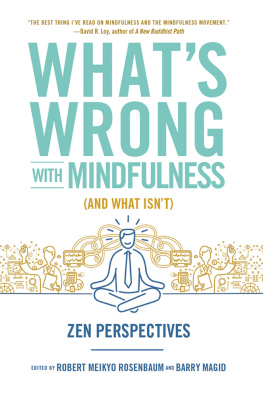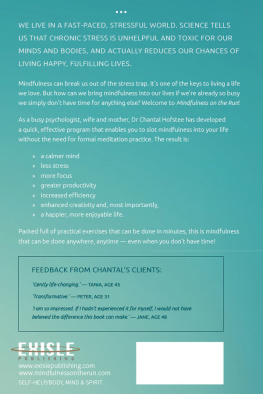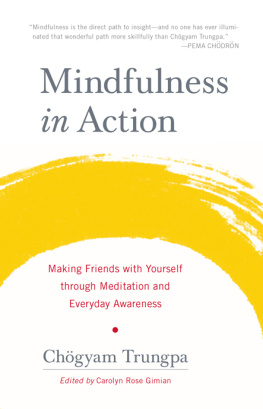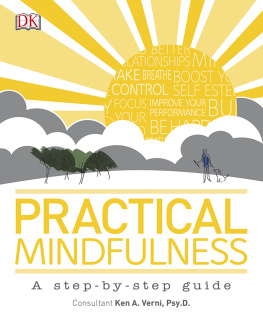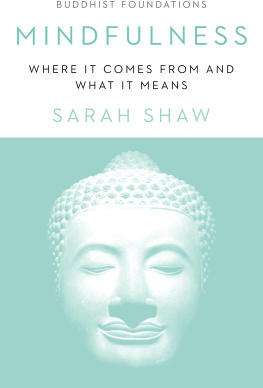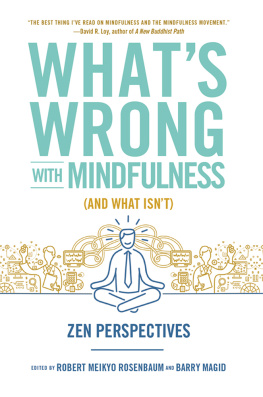PRAISE FOR
WHATS WRONG WITH MINDFULNESS
The essays illuminate each other, like the facets of a jewel.
Linda Galijan, San Francisco Zen Center
I am awed, appreciative, and impressed by the daring of the editors to examine the meaning of the word mindfulness and how it is being lived.
Elana Rosenbaum, author of Being Well (Even When Youre Sick)
Raises urgent questions about Mindfulness capital M now that it has been extracted from its Buddhist roots.
Gaelyn Godwin, abbot, Auspicious Cloud Temple, Houston Zen Center
If youre really into mindfulness, if you really want to know about mindfulness deeply, then this is a book for you to read and, more, to contemplate. Be prepared to be moved.
Arthur C. Bohart, professor emeritus, California State University, Dominguez Hills

ARTICULATE AND COURAGEOUS, THIS BOOK EXPANDS OUR UNDERSTANDING OF MINDFULNESS AND MERGES DEEP RESPECT FOR TRADITION WITH THOROUGH ACCEPTANCE OF CONTEMPORARY TIMES.
Deborah Schoeberlein David, author of Living Mindfully

MINDFULNESS IS IN FASHION. Oprah loves it, Google teaches it to employees it has become widespread as a cure-all for stress, health problems and psychological difficulties, interpersonal trouble, and existential anxiety. But in the context of the Zen Buddhist tradition, what more might mindfulness have to offer?
The Zen teachers gathered here each offer a powerful perspective on what mindfulness means, its strengths, and the potential pitfalls of decontextualizing mindfulness practice:
- GIL FRONSDAL AND MAX ERDSTEIN THOUGHTFULLY EXPLORE THE RICH THERAVADAN ROOTS OF MINDFULNESS
- BARRY MAGID AND MARC POIRIER EXAMINE THE UNINTENDED SIDE EFFECTS OF EXPOSING A SPIRITUAL TRADITION TO THE DEMANDS OF CAPITALISM
- NORMAN FISCHER DEMONSTRATES HOW MINDFULNESS INFORMS HIS CREATIVE PROCESS
- SALLIE JIKO TISDALE ON MINDFULNESS MIXED INTO A POTPOURRI OF SPIRITUAL, MYSTICAL, AND SELF-HELP METHODS
- AND MORE, INCLUDING ESSAYS ON MINDFULNESS AND ENVIRONMENTALISM, SCIENCE, AND PSYCHOLOGY.
Each chapter offers insights to ground mindfulness in a deeper understanding of both where it comes from and where it might be headed.
INTRODUCTION
UNIVERSAL MINDFULNESS BE CAREFUL WHAT YOU WISH FOR?
Robert Meikyo Rosenbaum and Barry Magid
ZEN TEACHERS SPEAK TO MINDFULNESS
Half a century ago, Zen was the magic elixir that would save all of us in the West from ourselves. Beat poetry, the inner game of tennis, and the art of motorcycle maintenance even the nostrums of business management manuals all claimed to bear Zens imprimatur. Zen, with its spare aesthetic and paradoxical stories, seemed to offer an antidote to the stresses of conformity and the false promises of commercialism. As a bonus, it apparently provided a tried and true pathway to enlightenment for the spiritual seeker.
With time we learned that Zen is as it likes to proclaim nothing special. Its practitioners are not exempted from ordinary human frailties. Throughout its history in Asia, Zen, far from being the rarefied panacea we had imagined, suffered its disappointments and its scandals, its organizational struggles, personal rivalries, and internecine doctrinal conflicts. Zen in America and Europe also turned out to not be immune from muddles and missteps. This was disillusioning but also, ultimately, refreshing: rather than pretending to be some precious, idealized practice, Zen in the West had to become real.
Being real means engaging with all the bits and pieces of everyday life. But what should that look like? A series of woodblock prints famous in the Zen tradition the Ox-Herding Pictures depicts the various stages of a spiritual journey. The tenth and final picture depicts the culmination of practice as returning to the marketplace with bliss-bestowing hands. The marketplace represents the hubbub of daily life with its jostle and noise, its glitter and its dust; this tenth Ox-Herding picture offers a vision of how a mature practitioner, forged by the rigors of the long quest, is able to return to everyday affairs and be in the world but not of it. Appearing as deeply ordinary, still she lives a life that supports the liberation of all beings.
In Zen we like to say the lotus blooms in the mud and the mud is pretty interesting, too. Since its arrival in the West, Zen has had its share of mud: teachers who did not live up to the ethical standards expected of them; difficulties supporting some practice centers while other groups thrived using commercial business models; arguments about how to stay true to tradition while also fostering the emergence of new forms of practice. In spite of and sometimes even because of these difficulties, Zen in the West has provided a deeply satisfying spiritual path for many, and the liberation it offers not only survived its journey to the West but has arguably been reinvigorated as its devoted practitioners struggled to make sense of it in its new time and place.
Now it is mindfulnesss turn to be appropriated by Western culture as the philosophers stone. Sometimes idealized as a cure-all and sometimes vilified as a New Age pablum, it has spread into society at large and, like Zen, expanded beyond its original training venues, religious practices, and cultural contexts. Mindfulness is becoming a generic term whose meaning becomes less clear in direct proportion to the hype it generates. It can be found everywhere; corporate retreats, medical centers, sports facilities, and even the military have adopted it as a way to decrease stress and improve performance.
Mindfulness has indeed entered the marketplace in the West, but it is questionable whether its hands are always bliss bestowing; there is even a danger of them becoming as grasping as all the other hands to be found there. This is not because mindfulnesss proponents are greedily chasing after money though sadly that seems to be a not-infrequent phenomenon but because the movement seems preoccupied with results. This goal-oriented grasping has streamlined and mass marketed what Chgyam Trungpa Rinpoche, a generation ago, so aptly called spiritual materialism.
The Heart Sutra, a text at the very core of Mahayana Buddhist teaching, proclaims there is no path, no wisdom, and no gain. No gain is the very antithesis of spiritual materialism; it rejects any means-to-an-end conceptualization or use of meditation. Preserving the centrality of no gain is how Zen can potentially maintain its integrity in the midst of a marketplace-based society. To the extent that it has been able to do so, Zen, for all its stumbles and excesses, is uniquely positioned to serve as an examplar to the mindfulness movement as it makes its own attempt to bring a Buddhist practice to the world without the world in turn contaminating the heart of Buddhist practice.
The Zen teachers assembled here, representing many different lineages and styles of teaching, have all been deeply schooled in the attitude of no gain. We also have practical experience wrestling with the knotty issue of how to take practices derived from Asian Buddhism and adapt them to our Western context while remaining true to the healthy roots on which they rely. For instance, all of us are engaged in teaching laypeople who may never see the inside of a monastery and who certainly will not live lives adhering to the strict list of precepts that govern Buddhist monastics. Although mindfulness is most intimately associated with the Theravada or Vipassana traditions, mindfulness also plays an important role in Zen (though often in subtly different forms). We hope by sharing our perspectives we may be able to contribute some insight to the issues our friends in the mindfulness movement face.
Next page
